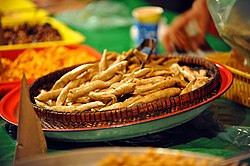Lekor
 Lekor, made from selected fish. | |
| Type | Snack |
|---|---|
| Place of origin | Malaysia |
| Region or state | Terengganu[1] |
| Created by | Malay |
| Serving temperature | Hot |
| Main ingredients | Fish, sago flour |
Lekor (Malay pronunciation: [lekor]), keropok lekor (Malay pronunciation: [kəropoʔ lekor]) or fish sausage is a traditional Malay fish cracker snack originating from the state of Terengganu, Malaysia.[2][3] It is made from fish and sago flour and seasoned with salt and sugar. It is slightly greyish in colour and gives off a fishy taste[4] and smell which becomes more prominent as it cools down after frying. The word lekor is said to be derived from a Terengganu Malay word meaning "to roll".
It is usually made by grinding fish or vegetables into a paste, mixing it with sago and then deep-frying it. It comes in three main forms: lekor (long and chewy), rebus (steamed) and keping (thin and crispy).
There are two types of keropok lekor which are the keropok lekor goreng and keropok lekor keping - the former are shaped like sausages with a chewy texture whereas the latter is cut into slices prior to frying, giving its crispier texture.
The snack is eaten with special homemade chili blends that are particular to Terengganu and sold there;[2] though modern innovations like adding mayonnaise and cheese sauce (the combination known locally as "keropok cheese") may also be available.
Gallery
-
Lekor with sauce.
References
- ^ "Keropok Lekor". JKKN. 2016. Retrieved 8 December 2017.
- ^ a b "Keropok Lekor". Tourism Terengganu. Archived from the original on 6 March 2014. Retrieved 20 August 2013.
- ^ "Lekor". dof.gov.my. Archived from the original on 16 August 2014. Retrieved 22 May 2014.
- ^ "Keropok Anyone". Malaysia Footsteps. 2009-06-22. Retrieved 22 May 2014.

